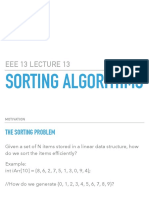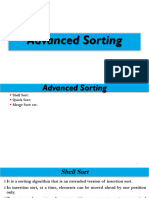0% found this document useful (0 votes)
63 views23 pagesWeek 3 - Part 1
This document discusses sorting algorithms and covers selection sort, insertion sort, and merge sort. Selection sort runs in Θ(n2) time for all inputs but is simple to implement. Insertion sort also runs in O(n2) time but can be faster for nearly sorted data. Merge sort divides the array in half, sorts each half recursively, and then merges the halves together in linear time, resulting in an overall runtime of Θ(nlg(n)).
Uploaded by
Nurbek NussipbekovCopyright
© © All Rights Reserved
We take content rights seriously. If you suspect this is your content, claim it here.
Available Formats
Download as PDF, TXT or read online on Scribd
0% found this document useful (0 votes)
63 views23 pagesWeek 3 - Part 1
This document discusses sorting algorithms and covers selection sort, insertion sort, and merge sort. Selection sort runs in Θ(n2) time for all inputs but is simple to implement. Insertion sort also runs in O(n2) time but can be faster for nearly sorted data. Merge sort divides the array in half, sorts each half recursively, and then merges the halves together in linear time, resulting in an overall runtime of Θ(nlg(n)).
Uploaded by
Nurbek NussipbekovCopyright
© © All Rights Reserved
We take content rights seriously. If you suspect this is your content, claim it here.
Available Formats
Download as PDF, TXT or read online on Scribd
/ 23































































































